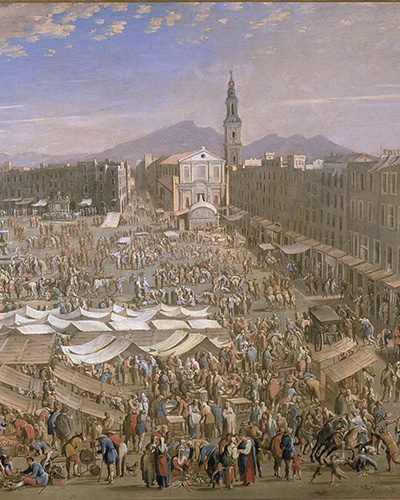This work, a frontal image of the royal palace in Naples, is recorded in the inventory of Francisco de Benavides' estate, drawn up at his death in 1716, with the number 87 and the following description: "Two perspectives, one of the market square of Naples by Mico espattaro for one hundred doubloons and the other is the Palace of the city by another author for twenty-five doubloons...".
Curiously, this inventory, drawn up by the painter and treatise writer Antonio Palomino, correctly identifies the work by Domenico Gargiulo (Micco Spadaro), signed only with a small monogram, and ignores the author of this signed and dated work in the lower right corner, which gives an idea of the different knowledge or interest in the work of the two artists in Madrid in the early 18th century. It is logical that the royal painter did not know the author, as this is the earliest known Neapolitan view by Angelo Maria Costa and the only one executed in the viceroyalty, as everything suggests that he later moved to Rome and finally to Lombardy, which is why most of his work is in Vienna and Eastern Europe (Capolavori... 1997, p. 142).
The canvas is dated 1696, the same year in which the 9th Count of Santisteban left the viceroyalty, and is one of the few views of the royal palace that does not depict a singular event. This dual circumstance suggests that the viceroy was commissioned to immortalise the memory of the palace from which he had governed the viceroyalty for eight years and of the everyday atmosphere of the social and political centre of his capital. In this purpose, which anticipates the mentality that would drive eighteenth-century Vedutism with the Grand Tour, the elevated point of view, which gives the foreground to the life of the great esplanade of "il largo di Palazzo" (M. Borobia, 2011, p. 248), as well as the one which, in the same way, gives the viewer the opportunity to see the life of the palace from a different point of view (M. Borobia, 2011, p. 248). 248) and the fact that, in the inventories, this work is cited as a "pendant" to a much earlier view, that of the Neapolitan market by Micco Spadaro, which painstakingly reflects scenes of daily life in another of the city's centres and which must have been included in the viceroy's collection much earlier.
In this front view, Costa shows the physiognomy of the vice-regal palace as it was conceived almost a century earlier by Domenico Fontana, although it has been considerably transformed today by the eighteenth-century alterations of Luigi Vanvitelli.
This canvas, along with the rest of the collection of the house of Santisteban, passed to the house of Medinaceli in 1789 through the marriage of the 3rd Duchess of Medinaceli to the 13th Duke of Medinaceli, a collection which, as most of it was linked by entailed estate, was preserved in its entirety until its legal division at the end of the 19th century and its physical division at the beginning of the next century.



